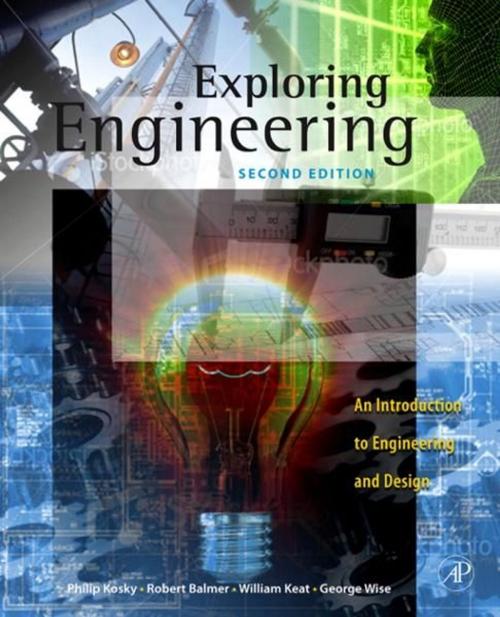Exploring Engineering
An Introduction to Engineering and Design
Nonfiction, Science & Nature, Technology, Engineering, Industrial| Author: | Philip Kosky, Robert T. Balmer, Robert T. Balmer, William D. Keat, William D. Keat, George Wise, George Wise | ISBN: | 9780080884462 |
| Publisher: | Elsevier Science | Publication: | September 5, 2009 |
| Imprint: | Academic Press | Language: | English |
| Author: | Philip Kosky, Robert T. Balmer, Robert T. Balmer, William D. Keat, William D. Keat, George Wise, George Wise |
| ISBN: | 9780080884462 |
| Publisher: | Elsevier Science |
| Publication: | September 5, 2009 |
| Imprint: | Academic Press |
| Language: | English |
Exploring Engineering: An Introduction to Engineering and Design, Second Edition, provides an introduction to the engineering profession. It covers both classical engineering and emerging fields, such as bioengineering, nanotechnology, and mechatronics.
The book is organized into two parts. Part 1 provides an overview of the engineering discipline. It begins with a discussion of what engineers do and then covers topics such as the key elements of engineering analysis; problems solving and spreadsheet analyses; and the kinds, conversion, and conservation of energy. The book also discusses key concepts drawn from the fields of chemical engineering; mechanical engineering; electrical engineering; electrochemical engineering; materials engineering; civil engineering; engineering kinematics; bioengineering; manufacturing engineering; and engineering economics. Part 2 focuses on the steps in the engineering design process. It provides content for a Design Studio, where students can design and build increasingly complex engineering system. It also presents examples of design competitions and concludes with brief remarks about the importance of design projects.
- Organized in two parts to cover both the concepts and practice of engineering: Part I, Minds On, introduces the fundamental physical, chemical and material bases for all engineering work while Part II, Hands On, provides opportunity to do design projects
- An Engineering Ethics Decision Matrix is introduced in Chapter 1 and used throughout the book to pose ethical challenges and explore ethical decision-making in an engineering context
- Lists of "Top Engineering Achievements" and "Top Engineering Challenges" help put the material in context and show engineering as a vibrant discipline involved in solving societal problems New to this edition:
- Additional discussions on what engineers do, and the distinctions between engineers, technicians, and managers (Chapter 1)
- New coverage of Renewable Energy and Environmental Engineering helps emphasize the emerging interest in Sustainable Engineering
- New discussions of Six Sigma in the Design section, and expanded material on writing technical reports
- Re-organized and updated chapters in Part I to more closely align with specific engineering disciplines
new end of chapter excercises throughout the book
Exploring Engineering: An Introduction to Engineering and Design, Second Edition, provides an introduction to the engineering profession. It covers both classical engineering and emerging fields, such as bioengineering, nanotechnology, and mechatronics.
The book is organized into two parts. Part 1 provides an overview of the engineering discipline. It begins with a discussion of what engineers do and then covers topics such as the key elements of engineering analysis; problems solving and spreadsheet analyses; and the kinds, conversion, and conservation of energy. The book also discusses key concepts drawn from the fields of chemical engineering; mechanical engineering; electrical engineering; electrochemical engineering; materials engineering; civil engineering; engineering kinematics; bioengineering; manufacturing engineering; and engineering economics. Part 2 focuses on the steps in the engineering design process. It provides content for a Design Studio, where students can design and build increasingly complex engineering system. It also presents examples of design competitions and concludes with brief remarks about the importance of design projects.
- Organized in two parts to cover both the concepts and practice of engineering: Part I, Minds On, introduces the fundamental physical, chemical and material bases for all engineering work while Part II, Hands On, provides opportunity to do design projects
- An Engineering Ethics Decision Matrix is introduced in Chapter 1 and used throughout the book to pose ethical challenges and explore ethical decision-making in an engineering context
- Lists of "Top Engineering Achievements" and "Top Engineering Challenges" help put the material in context and show engineering as a vibrant discipline involved in solving societal problems New to this edition:
- Additional discussions on what engineers do, and the distinctions between engineers, technicians, and managers (Chapter 1)
- New coverage of Renewable Energy and Environmental Engineering helps emphasize the emerging interest in Sustainable Engineering
- New discussions of Six Sigma in the Design section, and expanded material on writing technical reports
- Re-organized and updated chapters in Part I to more closely align with specific engineering disciplines
new end of chapter excercises throughout the book















